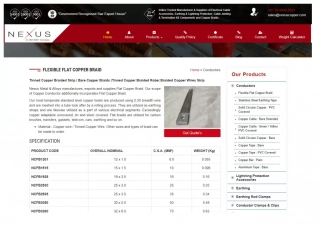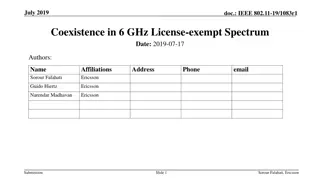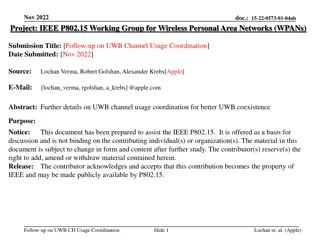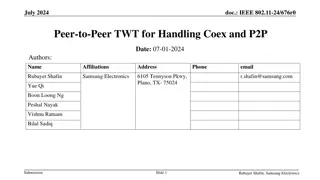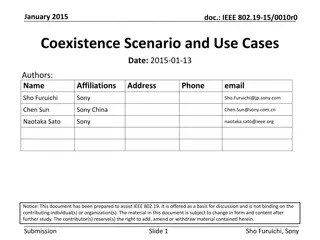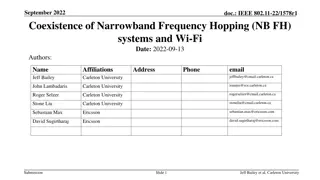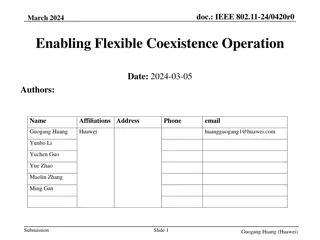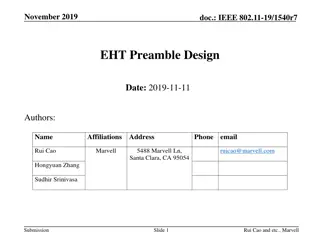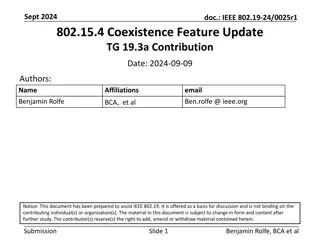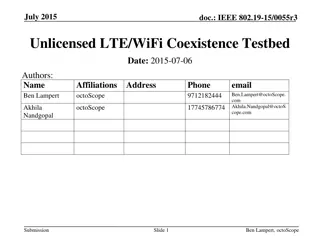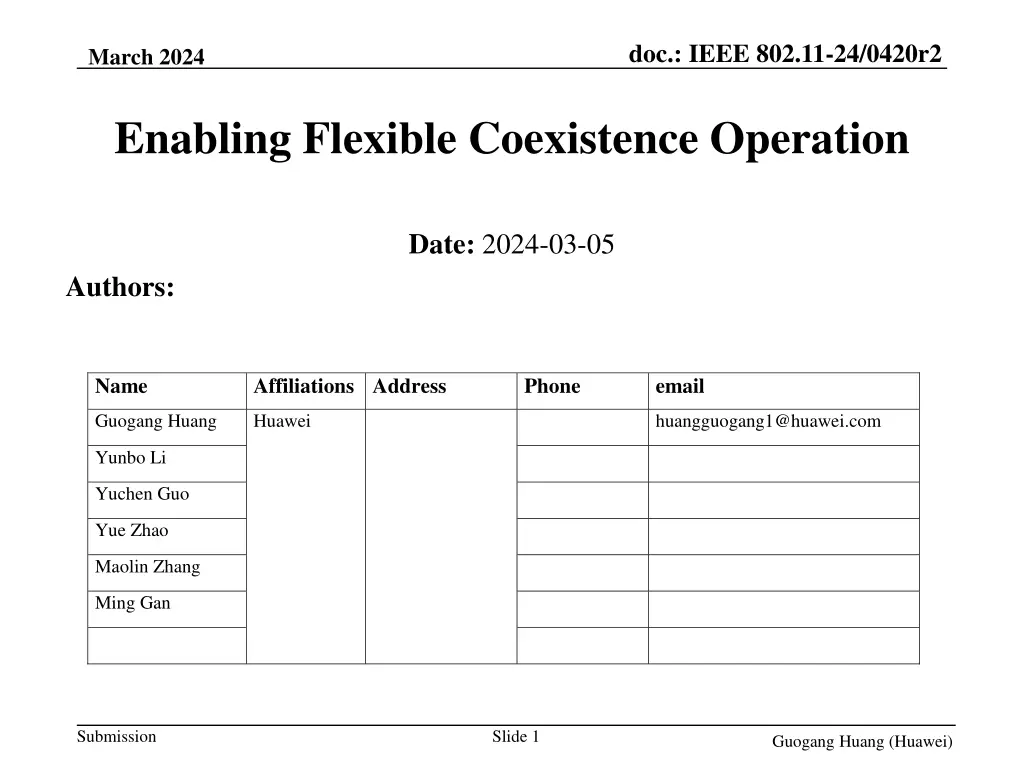
Enabling Flexible Coexistence Operation in IEEE 802.11-24 Standard
Explore the March 2024 document on enabling flexible coexistence operation within the IEEE 802.11-24 standard. The content discusses in-device coexistence models, requirements, and coexistence request management, offering insights for improving wireless communication efficiency.
Download Presentation

Please find below an Image/Link to download the presentation.
The content on the website is provided AS IS for your information and personal use only. It may not be sold, licensed, or shared on other websites without obtaining consent from the author. If you encounter any issues during the download, it is possible that the publisher has removed the file from their server.
You are allowed to download the files provided on this website for personal or commercial use, subject to the condition that they are used lawfully. All files are the property of their respective owners.
The content on the website is provided AS IS for your information and personal use only. It may not be sold, licensed, or shared on other websites without obtaining consent from the author.
E N D
Presentation Transcript
doc.: IEEE 802.11-24/0420r2 March 2024 Enabling Flexible Coexistence Operation Date: 2024-03-05 Authors: Name Affiliations Address Phone email Guogang Huang Huawei huangguogang1@huawei.com Yunbo Li Yuchen Guo Yue Zhao Maolin Zhang Ming Gan Submission Slide 1 Guogang Huang (Huawei)
doc.: IEEE 802.11-24/0420r2 March 2024 Introduction Several contributions [1-4] has discussed the in-device coexistence. In this contribution, we will share some thoughts on the in-device coexistence. Submission Slide 2 Guogang Huang (Huawei)
doc.: IEEE 802.11-24/0420r2 March 2024 Recap In-device Coexistence In-device non-WiFi radio types: BT, BLE, UWB, 5G NR-U In-device non-WiFi radio application profiles: Periodic Aperiodic. The STA can report periodic or aperiodic unavailable SPs due to the in-device coexistence. Start time, interval, Duration Affected BW in unit of 20 MHz Submission Slide 3 Guogang Huang (Huawei)
doc.: IEEE 802.11-24/0420r2 March 2024 In-device Coexistence Model The in-device coexistence model is illustrated as shown in the below figure Submission Slide 4 Guogang Huang (Huawei)
doc.: IEEE 802.11-24/0420r2 March 2024 Requirements Since a coexistence request may be received at anytime, the UHR coexistence protocol should allow a non-AP MLD timely reports an in-device coexistence request to the peer STA through one of following potential manners: Initial Control frame exchange at the beginning of a TXOP e.g. MU-BSRP/BSR BA frame Cross-link signaling through A-Control field or a newly defined Management frame So prefer to define a new signaling container, rather than reuse the TWT signaling. Submission Slide 5 Guogang Huang (Huawei)
doc.: IEEE 802.11-24/0420r2 March 2024 Coexistence Request ID For the periodic interference, the STA is easy to predict in advance but hard to predict its end. For example, The interference may be not always present during these interference SPs The interference may end before the indicated time point due to the transmission of the non-WiFi radio ends in advance. In order to facilitate the management of coexistence Requests and signaling, the non-AP MLD can assign an ID, named Coexistence Request ID, to uniquely identify a coexistence request when it is added. Thus the non-AP MLD can flexibly manage an existing coexistence request by using the corresponding Coexistence Request ID when the behavior of the corresponding non-WiFi radio is changed. Submission Slide 6 Guogang Huang (Huawei)
doc.: IEEE 802.11-24/0420r2 March 2024 Coexistence Request Type After a coexistence request is added, the non-AP MLD may remove/suspend/revise this coexistence request. Define a Coexistence Request Type to indicate the specific operation, as shown in below table. Table Coexistence Request Type definitions Value 0 1 2 3 Name Add Remove Suspend Revise Submission Slide 7 Guogang Huang (Huawei)
doc.: IEEE 802.11-24/0420r2 March 2024 Unavailable for Tx, Rx, or both Considering a STA could be an interfering or interfered one, the STA unavailability can be classified into the following three cases: Unavailable for Tx and Rx Scenario. share a common antenna with other non-WiFi radio Unavailable for Tx only Scenario. the interference between Wi-Fi radio and 5G NR-U radio which does the DL reception Unavailable for Rx only Scenario 1. the interference between Wi-Fi radio and 5G NR-U radio which does the UL transmission Scenario 2. the interference between Wi-Fi radio and the BT Radio. And the BT radio as the master transmits a unidirectional audio flow (i.e. no ACK) to the BT headset. This info could be used for the aligned Tx/Rx between Wi-Fi radio and non-WiFi radio. In addition, the Radio Type (e.g. 5G NR-U, BT and so on) may be reported to help the AP make decision on scheduling the STA s Tx/Rx. Submission Slide 8 Guogang Huang (Huawei)
doc.: IEEE 802.11-24/0420r2 Unavailable for Tx, Rx, or both (Cont.) Example 1. Asymmetric interference between Wi-Fi radio and non-WiFi radio due to the significant differences on the transmission power and the bandwidth (See Appendix). The reception of the Wi-Fi radio maybe can tolerate the short-time interference from the BT, e.g. replying ACK. But the reception of the BT radio cannot tolerate the interference generated by the Wi-Fi Radio. Then the STA reports periodic unavailable windows for Tx only to the associated AP. Unavailable for Tx only Unavailable for Tx only STA Time In-device Tx Window e.g. 1.25 ms Tx Window (e.g. 1.25 ms) A C K A C K A C K A C K BT as Master Time BT as slave (Headset) Data Data Data Data Connection Interval Submission Slide 9 Guogang Huang (Huawei)
doc.: IEEE 802.11-24/0420r2 Unavailable for Tx, Rx, or both (Cont.) Example 2. Asymmetric interference between Wi-Fi radio and non-WiFi radio due to the unidirectional Tx with no ACK The BT radio periodically advertises. Or the BT radio activates a transmission mode with no ACK for the real-time application. Then the STA reports periodic unavailable windows for Rx only to the associated AP. Unavailable for Rx only Unavailable for Rx only STA Time In-device Tx Window (e.g. 1.25 ms) Tx Window (e.g. 1.25 ms) BT as Master Data Data Time Connection Interval BT as slave (Headset) Submission Slide 10 Guogang Huang (Huawei)
doc.: IEEE 802.11-24/0420r2 March 2024 Conclusions In this contribution, we have proposed the following signaling designs for the in-device coexistence: The non-AP MLD assigns a Coexistence Request ID for each coexistence request. The non-AP MLD can add/revise/suspend/remove a coexistence request by indicating the corresponding Coexistence Request ID The non-AP MLD indicates whether it is unavailable for Tx, Rx or both within periodic/aperiodic SPs indicated by a coexistence request. Submission Slide 11 Guogang Huang (Huawei)
doc.: IEEE 802.11-24/0420r2 March 2024 References [1] 11-23-0816-01-0uhr-enhancements-for-latency- sensitive-traffic-and-in-device-coexistence [2]11-23-0298-00-0uhr-improved-reliability-in-presence- of-interference [3] 11-23-1103-00-0uhr-in-device-interference-discussion [4] 11-23-1964-01-00bn-coexistence-protocols-for-uhr Submission Slide 12 Guogang Huang (Huawei)
doc.: IEEE 802.11-24/0420r2 Appendix Tx Power of Bluetooth Submission Slide 13 Guogang Huang (Huawei)
doc.: IEEE 802.11-24/0420r2 SP 1 Do you support to define the following unavailable types for the in-device co-existence to improve the transmission and medium efficiency? Unavailable for Tx Only Unavailable for Rx Only Unavailable for both Tx and Rx Submission Slide 14 Guogang Huang (Huawei)
doc.: IEEE 802.11-24/0420r2 SP 2 Do you support to define a new signaling including parameters for the in-device coexistence? Submission Slide 15 Guogang Huang (Huawei)

